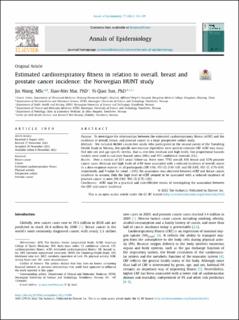| dc.contributor.author | Wang, Jin | |
| dc.contributor.author | Mai, Xiao-Mei | |
| dc.contributor.author | Sun, Yi-Qian | |
| dc.date.accessioned | 2023-04-18T06:33:34Z | |
| dc.date.available | 2023-04-18T06:33:34Z | |
| dc.date.created | 2022-12-13T15:26:53Z | |
| dc.date.issued | 2022 | |
| dc.identifier.citation | Annals of Epidemiology. 2022, 77 103-109. | en_US |
| dc.identifier.issn | 1047-2797 | |
| dc.identifier.uri | https://hdl.handle.net/11250/3063440 | |
| dc.description.abstract | Purpose
To investigate the relationships between the estimated cardiorespiratory fitness (eCRF) and the incidence of overall, breast, and prostate cancer in a large prospective cohort study.
Methods
We included 46,968 cancer-free adults who participated in the second survey of the Trøndelag Health Study in Norway. Sex-specific non-exercise algorithms were used to estimate CRF. eCRF was classified into sex and age-specific tertiles, that is, into low, medium and high levels. Cox proportional hazards models were used to calculate hazard ratios (HRs) and 95% confidence intervals (CIs).
Results
Over a median of 22.1 years’ follow-up, there were 7752 overall, 858 breast and 1376 prostate cancer cases. Medium and high levels of eCRF were associated with a reduced incidence of overall cancer in a dose-response manner in all participants (HR 0.96; 95% CI, 0.90–1.01 and HR 0.85; 95% CI, 0.79–0.91, respectively, and P-value for trend <.001). No association was observed between eCRF and breast cancer incidence in women. Only the high level of eCRF seemed to be associated with a reduced incidence of prostate cancer in men (HR 0.85; 95% CI, 0.72–1.02).
Conclusions
eCRF may be a practical and cost-effective means of investigating the association between the CRF and cancer incidence. | en_US |
| dc.language.iso | eng | en_US |
| dc.publisher | Elsevier | en_US |
| dc.rights | Navngivelse 4.0 Internasjonal | * |
| dc.rights.uri | http://creativecommons.org/licenses/by/4.0/deed.no | * |
| dc.title | Estimated cardiorespiratory fitness in relation to overall, breast and prostate cancer incidence: The Norwegian HUNT Study | en_US |
| dc.title.alternative | Estimated cardiorespiratory fitness in relation to overall, breast and prostate cancer incidence: The Norwegian HUNT Study | en_US |
| dc.type | Peer reviewed | en_US |
| dc.type | Journal article | en_US |
| dc.description.version | publishedVersion | en_US |
| dc.source.pagenumber | 103-109 | en_US |
| dc.source.volume | 77 | en_US |
| dc.source.journal | Annals of Epidemiology | en_US |
| dc.identifier.doi | 10.1016/j.annepidem.2022.11.008 | |
| dc.identifier.cristin | 2092694 | |
| dc.relation.project | Kreftforeningen: 182688-2016 | en_US |
| dc.relation.project | Samarbeidsorganet mellom Helse Midt-Norge og NTNU: 2018/42794 | en_US |
| cristin.ispublished | true | |
| cristin.fulltext | postprint | |
| cristin.qualitycode | 1 | |

